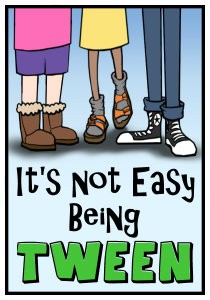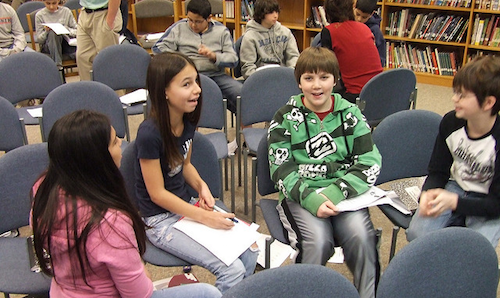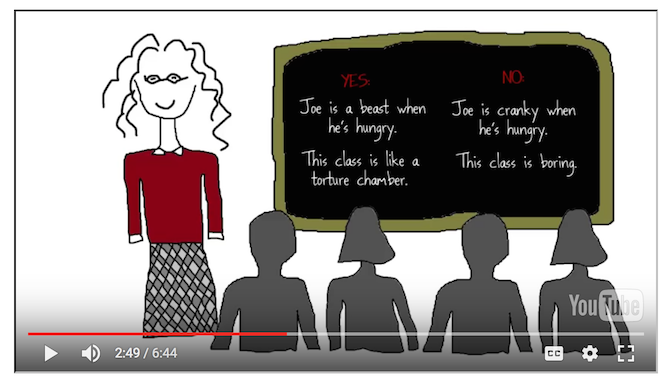School Leadership 2.0
A Network Connecting School Leaders From Around The Globe
Why I Love This Strategy to Introduce Concepts
Why I Love This Strategy to Introduce Concepts
BY CHERYL MIZERNY · PUBLISHED 01/15/2017
A MiddleWeb Blog
 The majority of the instruction in my classroom is informed by my knowledge of and fondness for constructivist learning strategies. I am not a fan of the traditional lecture “sit and get” format of teaching.
The majority of the instruction in my classroom is informed by my knowledge of and fondness for constructivist learning strategies. I am not a fan of the traditional lecture “sit and get” format of teaching.
I much prefer that the students’ brains are working at least as hard as mine. To that end, I have found great success using the Concept Attainment strategy.
Concept Attainment is a form of structured inquiry based upon the research of psychologist Jerome Bruner. In a nutshell, Concept Attainment is when students must determine common attributes within a group of examples provided by the teacher.
In 1956, psychologist Jerome Bruner published “A Study of Thinking.” Bruner was interested in cognitive processing – how people think, and how those tendencies might be used to inform teaching and learning processes. He developed a new way of introducing learners to new concepts called Concept Attainment. – TeachThought
What Concept Attainment looks like in practice
Developing and facilitating a Concept Attainment lesson is relatively simple. First, the instructor determines the concept to be learned (for example, “What is a metaphor?”).
Then the instructor determines several examples and non-examples of the concept. These examples and non-examples are presented to students as such. Working as a group, students determine the common characteristics of the examples and devise a working definition or hypothesis of the concept.
The groups then share their definitions and the teacher provides clarification and correction if necessary. Finally, the teams apply the concept to create new examples with the same attributes.
A sample lesson
Here is the technique in action, using the What is a metaphor?question:
- Concept Attainment is a backwards design strategy meaning that the lesson is designed to achieve a desired learning goal. In this case, the goal is a good working definition of metaphor(generally described at the middle school level as a figurative device that is a comparison of two unlike things without using like or as.
- With that definition in mind, the teacher offers several examples and non-examples of metaphor without defining it.
 https://www.middleweb.com/wp-content/uploads/2017/01/cm-metaphor-box-calibri-570-300x55.jpg 300w" sizes="(max-width: 570px) 100vw, 570px" />(Often, I just provide a list of examples and reserve non-examples for times when I feel it will make the point more effectively.)
https://www.middleweb.com/wp-content/uploads/2017/01/cm-metaphor-box-calibri-570-300x55.jpg 300w" sizes="(max-width: 570px) 100vw, 570px" />(Often, I just provide a list of examples and reserve non-examples for times when I feel it will make the point more effectively.)
- There are many ways these examples can be presented. I prefer that my students use this strategy in groups, so I often give all groups the same examples and let them work in small teams. However, this could be done as a whole class exercise.
- The groups (or whole class) then discuss the examples given and attempt to write a definition of the concept. I don’t give hints or provide affirmation during this work time. When students disagree about the definition and want me to decide, I throw it back to them and urge the opposing students to clarify their viewpoint by explaining why they believe they are correct.
 The groups share their definitions and, as a large group, develop a cohesive definition. At this point, I can provide clarification or correction (e.g., metaphor vs. simile) and/or finesse the definition by providing a more precise word choice or an academic vocabulary term of which they may be unaware.
The groups share their definitions and, as a large group, develop a cohesive definition. At this point, I can provide clarification or correction (e.g., metaphor vs. simile) and/or finesse the definition by providing a more precise word choice or an academic vocabulary term of which they may be unaware.
- Once the definition is developed, students are sent back to their groups or as individuals to apply this definition to new examples. This is also a time to be creative. In this case, students are to develop new metaphors.
- I make this activity fun by having them draw two random nouns from a stack of cards. They must determine a comparison between these two words – for example, a fish and a keyboard. They generally like to share their hilarious examples when finished. Depending on the concept taught, students could also make concept maps, sketch notes, draw Venn diagrams, or determine their own metaphor (when metaphors are not the desired learning target).
Other topics that fit well with Concept Attainment
As a language arts teacher, I have found numerous topics that I can introduce using the Concept Attainment strategy (“theme,” for example).
Other content areas in which the academic concepts are much more forthright find that this strategy is a perfect introduction to new topics such as classification of animals, types of governments, or mathematical formulas.
I teach my grammar lessons this way as well, and I call them “Sentence Study.” I based this on the work of my friend Jeff Anderson from his book Mechanically Inclined. I tweaked it to work for me.
 In my Sentence Study, the examples I give are mentor sentences from the novels we have read in class or others that are popular at the time. Each sentence targets the same grammatical concept (such as placement of commas in direct address). The students then work together to determine what all of the sentences have in common.
In my Sentence Study, the examples I give are mentor sentences from the novels we have read in class or others that are popular at the time. Each sentence targets the same grammatical concept (such as placement of commas in direct address). The students then work together to determine what all of the sentences have in common.
We then write an explanation of the rule being studied, and they go back and write or find their own examples. I also do these where each sentence has the exact same error such as in subject-verb agreement. They must determine the error and how it can be corrected.
The students really enjoy learning this way and often get excited anticipating these lessons. I have written before (“Our Students Often Learn Better Together”) about how I use Concept Attainment to help students determine characteristics of a writing genre. This could also be used to teach text structures, writing point of view, irony, spelling patterns, and much more.
9 reasons I love Concept Attainment
I am a huge fan of the Concept Attainment strategy for many reasons.
- It requires about the same amount of prep work as a coherent lecture, but it’s much more engaging and effective for my students.
- Teaching academic vocabulary can often be the most tedious thing teachers do, and this makes it enjoyable.
- I have found children have a much higher degree of retention when using inductive learning. They tend to remember the discussions they had which led to their a-ha moments – particularly if they have disagreed.
- Inductive learning is brain-friendly; our brains enjoy organizing information and determining patterns.
- Constructivism encourages critical thinking, which is one of my main goals as a teacher.
- Many gamification strategies encourage competition, but I always prefer collaboration. Their only competition here is with themselves in trying to figure out the rule.
- Near and dear to my heart is providing learning opportunities in which all students can be successful. Because I generally use Concept Attainment to introduce a new idea, it is a fairly level playing field.
- Because this is a low-stakes gamified way of learning, students are willing to take risks and make guesses because this activity is not for a letter grade.
- Most importantly for middle school—this is FUN. It’s like a puzzle or a mystery to solve. I almost never have off-task behavior, and it is easy to redirect if I do because I am not tied to a PowerPoint or lecture notes.
I can’t tell you how many times students who are typically considered weaker come up with the correct attributes first. Perhaps this is because they have no problem thinking creatively and outside the box.
As I wander the room during group discussions, if I see that a student is struggling to be heard (and has the correct answer), I will pause the group and throw a leading question their way or point out the student who I feel “has a good point” that was not acknowledged.
I have never seen this strategy be one in which a certain student is always correct or incorrect. All are successful at some point. If you have not tried a lesson like this, I highly encourage you to give it a go. You might find that you enjoy it as much as the children.
JOIN SL 2.0
SUBSCRIBE TO
SCHOOL LEADERSHIP 2.0
Feedspot named School Leadership 2.0 one of the "Top 25 Educational Leadership Blogs"
"School Leadership 2.0 is the premier virtual learning community for school leaders from around the globe."
---------------------------
Our community is a subscription-based paid service ($19.95/year or only $1.99 per month for a trial membership) that will provide school leaders with outstanding resources. Learn more about membership to this service by clicking one of our links below.
Click HERE to subscribe as an individual.
Click HERE to learn about group membership (i.e., association, leadership teams)
__________________
CREATE AN EMPLOYER PROFILE AND GET JOB ALERTS AT
SCHOOLLEADERSHIPJOBS.COM
New Partnership
Mentors.net - a Professional Development Resource
Mentors.net was founded in 1995 as a professional development resource for school administrators leading new teacher induction programs. It soon evolved into a destination where both new and student teachers could reflect on their teaching experiences. Now, nearly thirty years later, Mentors.net has taken on a new direction—serving as a platform for beginning teachers, preservice educators, and
other professionals to share their insights and experiences from the early years of teaching, with a focus on integrating artificial intelligence. We invite you to contribute by sharing your experiences in the form of a journal article, story, reflection, or timely tips, especially on how you incorporate AI into your teaching
practice. Submissions may range from a 500-word personal reflection to a 2,000-word article with formal citations.


You need to be a member of School Leadership 2.0 to add comments!
Join School Leadership 2.0